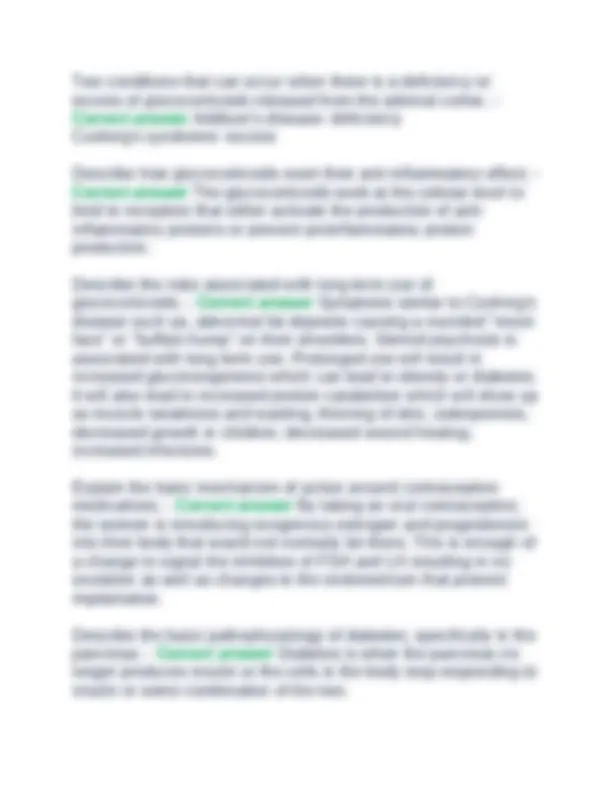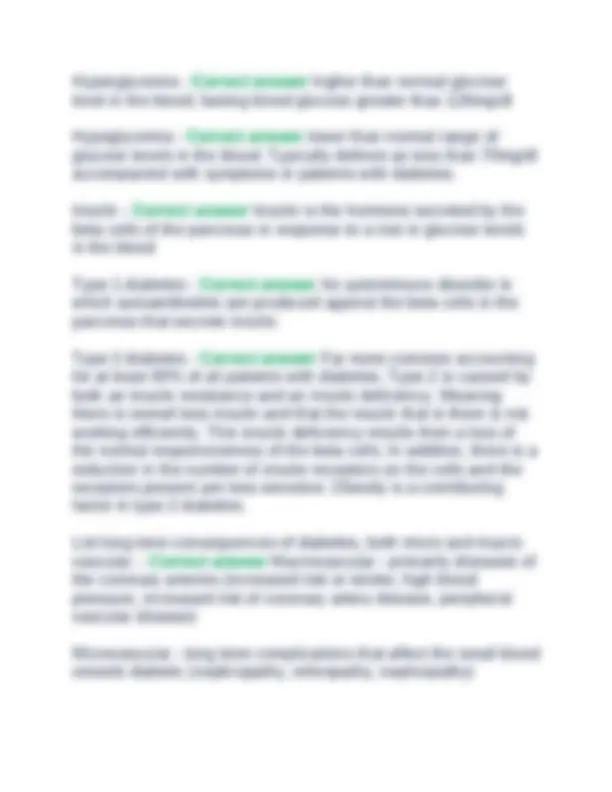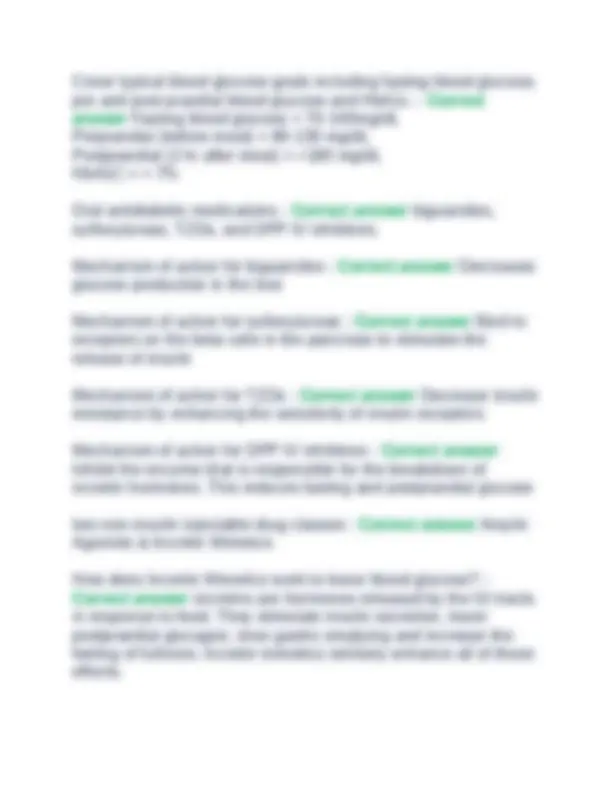





Study with the several resources on Docsity

Earn points by helping other students or get them with a premium plan


Prepare for your exams
Study with the several resources on Docsity

Earn points to download
Earn points by helping other students or get them with a premium plan
Community
Ask the community for help and clear up your study doubts
Discover the best universities in your country according to Docsity users
Free resources
Download our free guides on studying techniques, anxiety management strategies, and thesis advice from Docsity tutors
A comprehensive set of frequently tested questions and answers related to the endocrine system and diabetes, covering key concepts, hormones, disorders, and treatments. It is a valuable resource for students studying nurs 251, offering insights into common exam topics and providing a structured approach to understanding the subject matter.
Typology: Exams
1 / 6

This page cannot be seen from the preview
Don't miss anything!




Where in the body is the pituitary gland located? - Correct answer The pituitary gland is located in the brain near the hypothalamus. What is the primary substance released from the pituitary gland? - Correct answer Its primary role is to release hormones into the body that control other glands within the endocrine system. What are the two lobes of the pituitary gland called - Correct answer Anterior Pituitary Gland & Posterior Pituitary Gland Hormones associated with the anterior pituitary gland - Correct answer -Adrenocorticotropic Hormone (ACTH) -Follicle Stimulating Hormone (FSH) -Growth Hormone (GH) -Luteinizing Hormone (LH) -Prolactin (PH) -Thyroid Stimulating Hormone (TSH), Hormones associated with the posterior pituitary gland - Correct answer -Antidiuretic Hormone (ADH) -Oxytocin Uses of somatropin - Correct answer used in children who are deficient in Growth Hormone to promote linear growth Uses of octreotide - Correct answer Used in the treatment of severe watery diarrhea caused by a slow growing tumor
Uses of vasopressin - Correct answer used in emergency situations when blood pressure is dropping too low Uses of desmopressin - Correct answer used to treat certain blood disorders Two common disorders associated with the thyroid gland - Correct answer Hypothyroidism & Hyperthyroidism Hypothyroidism symptoms - Correct answer cold intolerance, unintentional weight gain, depression, dry brittle hair and nails, and fatigue Hyperthyroidism symptoms - Correct answer diarrhea, flushing, increased appetite, muscle weakness, fatigue, palpitations, irritability, nervousness, heat intolerance and altered menstrual flow What is levothyroxine? - Correct answer a synthetic thyroid hormone used in hypothyroidism Levothyroxine mechanism of action and special use instructions - Correct answer Essentially levothyroxine works in the same manner as the endogenous hormone, Thyroxine or T4. By taking levothyroxine, the deficiency is corrected. However, it can be impacted by food or drugs and so it is recommended to take on an empty stomach 30-60 minutes prior to breakfast. Hyperthyroidism drugs (and how they work) - Correct answer methimazole and propylthiouracil (PTU) are two antithyroid drugs available that work by inhibiting the formation of the thyroid hormones.
Hyperglycemia - Correct answer higher than normal glucose level in the blood; fasting blood glucose greater than 126mg/dl Hypoglycemia - Correct answer lower than normal range of glucose levels in the blood. Typically defines as less than 70mg/dl accompanied with symptoms in patients with diabetes. Insulin - Correct answer Insulin is the hormone secreted by the beta cells of the pancreas in response to a rise in glucose levels in the blood Type 1 diabetes - Correct answer An autoimmune disorder in which autoantibodies are produced against the beta cells in the pancreas that secrete insulin. Type 2 diabetes - Correct answer Far more common accounting for at least 90% of all patients with diabetes. Type 2 is caused by both an insulin resistance and an insulin deficiency. Meaning there is overall less insulin and that the insulin that is there is not working efficiently. This insulin deficiency results from a loss of the normal responsiveness of the beta cells. In addition, there is a reduction in the number of insulin receptors on the cells and the receptors present are less sensitive. Obesity is a contributing factor in type 2 diabetes. List long term consequences of diabetes, both micro and macro vascular. - Correct answer Macrovascular - primarily diseases of the coronary arteries (increased risk or stroke, high blood pressure, increased risk of coronary artery disease, peripheral vascular disease) Microvascular - long term complications that affect the small blood vessels diabetic (nephropathy, retinopathy, nephropathy)
Cover typical blood glucose goals including fasting blood glucose, pre and post prandial blood glucose and HbA1c. - Correct answer Fasting blood glucose = 70-140mg/dL Preprandial (before meal) = 80-130 mg/dL Postprandial (2 hr after meal) = <180 mg/dL HbA1C = < 7% Oral antidiabetic medications - Correct answer biguanides, sulfonylureas, TZDs, and DPP IV inhibitors. Mechanism of action for biguanides - Correct answer Decreases glucose production in the liver Mechanism of action for sulfonylureas - Correct answer Bind to receptors on the beta cells in the pancreas to stimulate the release of insulin Mechanism of action for TZDs - Correct answer Decrease insulin resistance by enhancing the sensitivity of insulin receptors Mechanism of action for DPP IV inhibitors - Correct answer Inhibit the enzyme that is responsible for the breakdown of incretin hormones. This reduces fasting and postprandial glucose two non-insulin injectable drug classes - Correct answer Amylin Agonists & Incretin Mimetics How does Incretin Mimetics work to lower blood glucose? - Correct answer incretins are hormones released by the GI tracts in response to food. They stimulate insulin secretion, lower postprandial glucagon, slow gastric emptying and increase the feeling of fullness. Incretin mimetics similarly enhance all of these effects.